
Have you ever wondered how big do ball pythons get?
Well, you’re in for a treat!
This article delves deep into the captivating world of ball pythons, exploring their growth patterns and the factors influencing their size.
From genetic makeup to environmental conditions, we’ve examined every facet to bring you a comprehensive understanding.
Whether you’re a curious reader or a potential snake owner, by the end of this piece, you’ll have a clear picture of the size range of these popular reptiles and what contributes to their growth.
Dive in and discover the intriguing journey of the ball python’s growth!
Table of Contents
- 1 How Big Do Ball Pythons Get? (Short Answer)
- 2 Typical Growth Patterns of Ball Pythons
- 3 Size Differences: Males vs. Females
- 4 The Impact of Captivity on Size
- 5 Record-Breaking Ball Pythons
- 6 Comparing Ball Pythons to Other Snake Species
- 7 Caring for Your Growing Ball Python
- 8 Conclusion
- 9 Frequently Asked Questions
How Big Do Ball Pythons Get? (Short Answer)
Ball pythons, native to West and Central Africa, are renowned for their relatively modest size, making them popular pets among snake enthusiasts. On average, male ball pythons reach lengths of 2 to 3 feet, while females, being slightly larger, typically grow between 3 to 5 feet. Their growth rate is influenced by factors like genetics, diet, and overall care.
Despite their gentle nature and manageable size, it’s essential for potential owners to be prepared for the commitment, as these reptiles can live up to 30 years in captivity. Always ensure they have adequate space to grow and thrive.
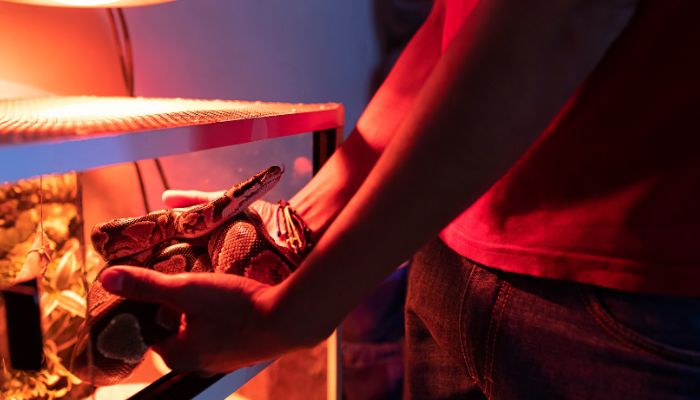
Typical Growth Patterns of Ball Pythons
Ah, the ball python! A favorite among reptile enthusiasts and a common sight in many households.
But one question that often pops up is: “Just how big do these slithering companions get?” Let’s dive deep into their growth patterns.
Growth rate from hatchling to adulthood
When ball pythons first emerge from their eggs, they’re tiny, measuring a mere 10 inches or so. But don’t be fooled by their initial size. Over the next few years, with the right care and environment, they undergo a significant transformation.
By the time they reach adulthood, which is around 3 to 5 years, they can be anywhere from 2 to 5 feet long. Quite the growth spurt, right?
Factors influencing their growth: genetics, diet, and environment
Like humans, genetics play a pivotal role in determining the size of a ball python. If both parent snakes were on the larger side, there’s a good chance their offspring will follow suit.
Diet is another crucial factor. A well-fed ball python that receives a consistent diet of appropriate-sized prey will generally grow at a steady rate.
On the flip side, underfeeding can stunt growth, while overfeeding can lead to obesity and other health issues.
Lastly, the environment plays a role too. A ball python that’s kept in an enclosure that’s too small might not grow to its full potential. Similarly, factors like temperature and humidity can influence growth rates.
For instance, ball pythons thrive in warmer temperatures, which can stimulate faster growth.
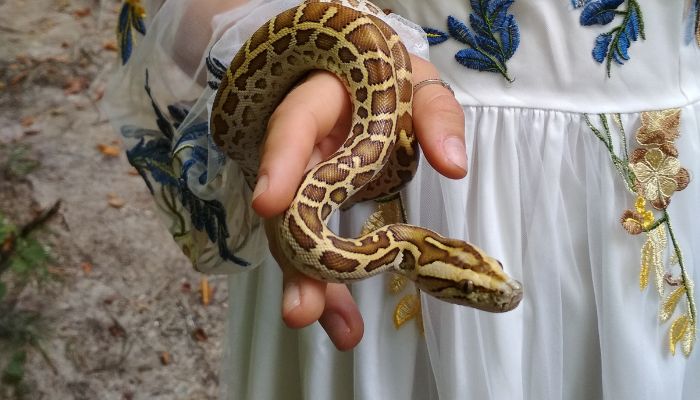
Size Differences: Males vs. Females
Alright, let’s address the elephant (or should I say snake?) in the room. Is there a size difference between male and female ball pythons? You bet there is!
Sexual dimorphism in ball pythons
Sexual dimorphism is a fancy term that means males and females of a species exhibit different characteristics beyond their reproductive organs. In the case of ball pythons, this difference is most evident in their size.
Average sizes for both genders and the reasons behind the differences
On average, male ball pythons are smaller, typically reaching lengths of 2 to 3 feet. Females, on the other hand, tend to be larger, often measuring between 3 to 5 feet. But why this difference? Well, it boils down to reproduction.
Female ball pythons need to be larger to carry and lay eggs. It’s a demanding process, and a larger body size helps accommodate the developing eggs.
In the wild, this size difference also plays a role in mating. Larger females can choose from multiple suitors, ensuring the best genes are passed on to the next generation.
The size of a ball python is influenced by a myriad of factors, from genetics to diet to environment.
Whether you’re a potential snake owner or just someone fascinated by these creatures, understanding their growth patterns and size differences can offer valuable insights into their intriguing world.
The Impact of Captivity on Size
When it comes to the size of ball pythons, captivity plays a significant role. While these snakes have adapted well to life in enclosures, the conditions they’re kept in can have a profound impact on their growth.
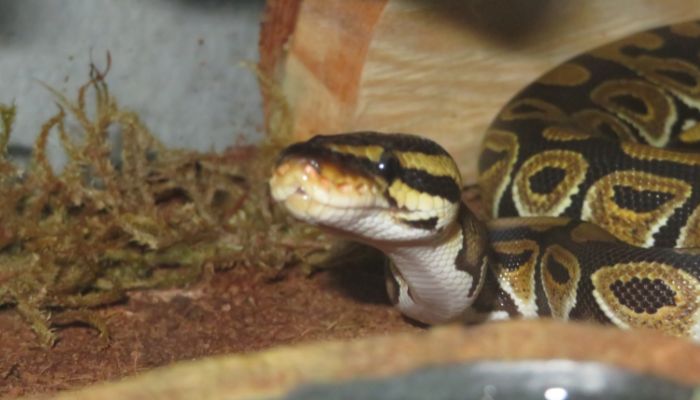
How living in captivity can influence growth
In the wild, ball pythons face a myriad of challenges, from predators to food scarcity. These factors naturally limit their growth. However, in captivity, many of these challenges are eliminated.
There are no predators to evade, and food is provided regularly. This might sound like an ideal scenario for growth, but it’s a double-edged sword.
Without the need to hunt or evade predators, captive ball pythons can become less active. Reduced activity can lead to slower metabolism and, in some cases, obesity.
Furthermore, the size of the enclosure can also influence growth. A small enclosure can restrict movement, potentially stunting growth.
The role of diet and care in determining size
Diet is paramount in determining the size of a ball python in captivity. A consistent diet of appropriate-sized prey ensures steady growth. However, overfeeding can lead to rapid weight gain, while underfeeding can stunt growth. It’s a delicate balance that requires keen observation and understanding of the snake’s needs.
Beyond diet, other aspects of care, like temperature and humidity, play a role. Ball pythons thrive in specific conditions. An environment that’s too cold or too dry can hinder growth and even lead to health issues.
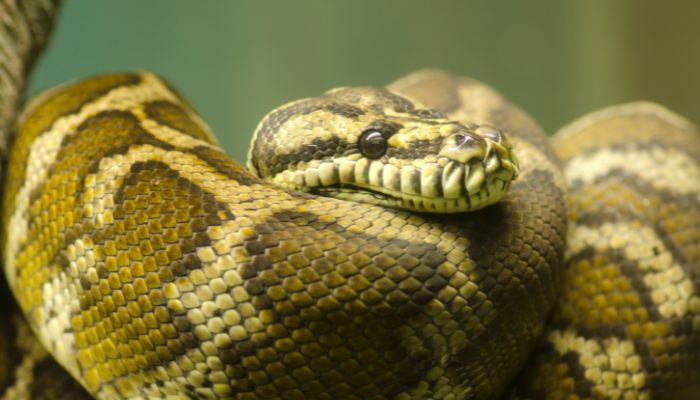
Record-Breaking Ball Pythons
Every now and then, we hear tales of ball pythons that defy the norms, growing to sizes that leave us in awe.
Unusually large ball pythons and their stories
There have been instances where ball pythons in captivity have surpassed the average size, reaching lengths of over 6 feet! One such story is of “Titan,” a ball python that grew to an astonishing 6.2 feet in a specialized reptile sanctuary.
Titan’s growth was attributed to a combination of genetics and exceptional care.
The oldest and largest ball pythons in captivity
Age and size often go hand in hand. The title for the oldest ball python in captivity goes to a snake that lived in the St. Louis Zoo, reaching an impressive age of 48 years.
As for the largest, while Titan holds a record, there are other contenders, with some reports of ball pythons nearing 7 feet, though such instances are rare.
In the end, while ball pythons have an average size, there are always exceptions to the rule. Whether it’s due to genetics, care, or a bit of both, these snakes continue to fascinate and surprise us with their growth stories.
Comparing Ball Pythons to Other Snake Species
The world of pet snakes is vast and varied, with each species bringing its unique charm to the table. When it comes to size, how does our beloved ball python stack up against other popular serpents?
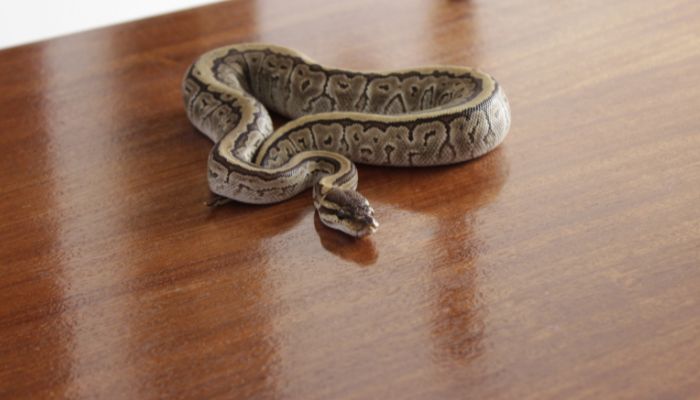
Size comparison with other popular pet snakes
Let’s start with the corn snake, another fan favorite. Typically, corn snakes can grow a bit longer than ball pythons, reaching lengths of 4 to 5.5 feet.
Then there’s the boa constrictor, a more substantial snake, which can grow anywhere from 8 to 12 feet, depending on the specific subspecies.
The garter snake, on the other hand, is on the smaller side, usually measuring between 2 to 3 feet. And let’s not forget the king snake, which can vary widely in size but generally falls in the 3 to 6-foot range.
What makes ball pythons stand out in terms of size
While ball pythons might not be the longest snakes out there, they have a robust, muscular build. Their girth, combined with their moderate length, gives them a distinctive appearance.
This stocky build, combined with their docile nature and striking patterns, makes them a standout choice for many snake enthusiasts.
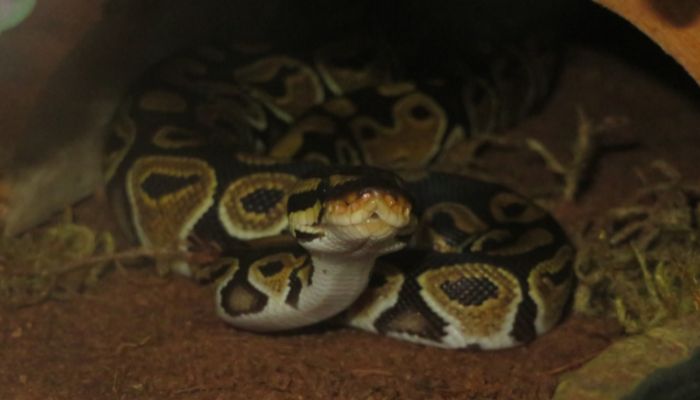
Caring for Your Growing Ball Python
Ah, the joys of watching your ball python grow! But with great power (or in this case, a growing snake) comes great responsibility. Let’s delve into the essentials of caring for these magnificent creatures.
Tips for ensuring healthy growth
- Consistent Feeding: Offer appropriately-sized prey every 1-2 weeks for adults and more frequently for younger snakes.
- Regular Check-ups: Just like any other pet, periodic visits to a reptile vet can help spot and address potential health issues.
- Handle with Care: Regular, gentle handling can reduce stress and promote overall well-being.
The importance of a balanced diet and proper enclosure
Diet plays a pivotal role in your python’s growth. A varied diet, consisting of mice and rats, ensures they get all the nutrients they need. Remember, overfeeding can lead to obesity, so it’s crucial to strike a balance.
As for the enclosure, size matters. A growing ball python needs space to move and explore. Ensure the enclosure is large enough for your snake to stretch out comfortably.
Also, maintain the right temperature and humidity levels to mimic their natural habitat.
In conclusion, while ball pythons are relatively easy to care for, they still require attention to detail, especially when it comes to their diet and environment.
With the right care, your ball python will thrive, providing you with years of companionship.
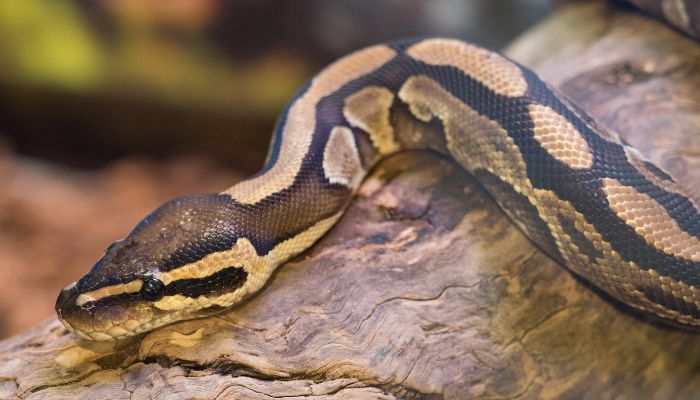
Conclusion
You’ve journeyed through the fascinating world of ball pythons, unraveling the mysteries behind their size and growth.
From understanding the typical growth patterns to comparing them with other snake species, you’ve gained a comprehensive insight into what influences their size, both in the wild and in captivity.
The role of genetics, diet, and environment plays a pivotal part in their growth, and it’s essential to consider these factors, especially if you’re thinking of keeping one as a pet.
Remember, every ball python is unique, and observing their individual growth patterns can be a rewarding experience.
As you move forward, whether you’re a potential snake owner or just someone with a keen interest, let this knowledge guide and inspire you. Embrace the wonders of the natural world, and always stay curious.
Your journey with these magnificent creatures is just beginning, and there’s so much more to explore and discover. Keep learning, and let your passion for understanding the world around you grow as vast as the horizon.
Frequently Asked Questions
Let’s tackle some of the most frequently asked questions about these captivating serpents.
At what age is a ball python full grown?
Ball pythons typically reach their full size by the age of 3 to 5 years. However, like humans, they might continue to grow a bit more, albeit at a much slower rate, throughout their lives.
How big is a 1 year old ball python?
A 1-year-old ball python is still very much in its growing phase. At this age, they usually measure between 20 to 30 inches in length. But remember, growth can vary based on factors like genetics, diet, and overall care.
How much do ball pythons weigh in kg?
The weight of a ball python can vary significantly based on its age, size, and health. On average, an adult ball python weighs between 1 to 2 kg. However, larger females might weigh a bit more, sometimes reaching up to 2.5 kg or more.
How long do ball pythons live?
With proper care, ball pythons have a surprisingly long lifespan. In captivity, they can live anywhere from 20 to 30 years, with some even reaching the ripe old age of 40!
How big do ball pythons get in captivity?
In captivity, ball pythons typically grow to lengths of 3 to 5 feet. Females tend to be on the larger side, sometimes reaching or slightly surpassing 5 feet, while males usually stay between 2 to 3 feet.




0 Comments